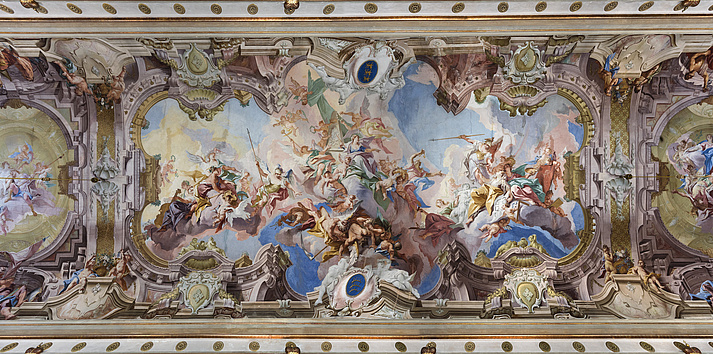Documentation, Interpretation and Digital Presentation

The Corpus of Baroque Ceiling Painting in Germany (CbDD) is dedicated to documenting and researching the art of mural painting during the Early Modern period, with a particular focus on monuments located in Germany. The project aims to expand knowledge and enhance understanding of this unique form of pictorial art, which thrived throughout Europe in the pre-modern era. The primary objectives of this research project are:
- Systematic appraisal and documentation of Baroque ceilings and wall decorations within their architectural, historical, iconographical, and thematic contexts. This involves utilizing archival sources, visual and textual documentation, new digital and historical photography, as well as available plan material.
- Analysis and Interpretation of these artistic monuments from a historical and inter-disciplinary perspective, considering the broader context of art patronage during the Early Modern period. Topics of exploration may include international networks of patrons and artists, the social status and influence of patrons within and beyond the Holy Roman Empire, the impact of politics and religious affiliations, the transfer and innovation of artistic knowledge across Europe, and the development of new techniques.
- Development of an innovative and interactive digital platform on the Internet to present the research findings in an open-access database. Conference papers and special editions featuring new material from the corpus will also be made available in a print-on-demand format. This ensures wide accessibility to the research results.
Historical Networks
The new corpus project takes a typological approach to study the monuments of Baroque wall and ceiling paintings in Germany, focusing on their characteristics rather than their specific locations. The material will be organized into typological sections based on historical, cultural, and social networks within the political landscape of the Holy Roman Empire and beyond. This methodological structure acknowledges the diverse cultural and political connections between patrons and painters across borders and throughout the Early Modern period.
Patronage: Courts and the Church
During the Early Modern era, the courts and the church played crucial roles as patrons of the arts. The world of early modern courts and their extensive networks across Europe provided a fertile ground for the flourishing of mural painting. This international system of artistic references greatly influenced the visual culture of cities and the art patronage of citizens, patricians, and the nobility. Additionally, the church was another significant player in this competitive system, establishing its sophisticated network of artistic patronage throughout Early Modern Europe.
Modules of the Corpus of Baroque Ceiling Painting in Germany
The Corpus of Baroque Ceiling Painting in Germany project is structured into four modules that align with the cultural and political reference system. These modules, presented in chronological order, are as follows:
- Courts, Palaces, and Residences (Module I)
- Communal and Private Buildings: Aristocratic and Civic (Module II)
- Monasteries, Priories, and Cathedrals (Module III)
- Parish churches, Pilgrimage Churches, and Chapels (Module IV)
